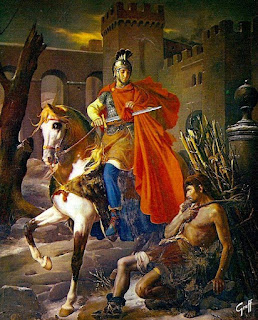Saint
Josaphat
Also
known as
Josaphat
Kuncevyc
Jehoshaphat
Kuncewycz
John
Kunsevich
Josaphat
Kuntsevych
Josaphat
of Polotsk
Jozofat
Kuncewicz
Memorial
12
November
Profile
Our Saint
today was raised as a Ruthenian Orthodox nut. In 1595 the Ruthenian church looked in the
mirror and said “look at these dopey hats we’re wearing,” and rejoined the
Church in Rome. Josaphat felt a call to
the religious life and so he turned down a business partnership and a
marriage to his partner’s daughter to pursue it.
He became
a monk a priest in the Byzantine Rite Catholic Church taking the name
Josaphat. As the East West union was still a hot button
issue back then, and still today, Our Saint’s monastic superior, Samuel, never
accepted the reunification, and actively fought against it.
You can still see these knuckleheads today…they’re the ones who turned their
backs on Pope Saint John Paul II when he came to visit them in a spirit of Love
and Fraternity back in the 1990’s. And the Devil
laughs.
Josaphat
learned of Samuel’s work, he understood the damage it was causing in the entire
Eastern Catholic Church so he squealed on Samuel. The
archbishop of Kiev became furious, removed Samuel from his post, replacing him
with Josaphat.
Josaphat
was a famous preacher and great leader who believed unity was the best course
of action and one The Master would want. Through his work and belief he
brought many Orthodox to the sensible hat side of
Christendom. This was all at a time when most religious, fearing
interference with the locally developed liturgy and customs, did not want union
with Rome.
With
his teaching, clerical reform, and personal example Josaphat won the greater
part of the Orthodox in Lithuania to the union. In needing to compromise where
compromise was possible, and by being diplomatic and pastoral to all his
actions were viewed by both East and West as subversive; neither side was
really happy with him. You can’t be everything for all.
His piety
and sincerity were very clear to everyone though; he was made Archbishop and as
such attended the Diet of Warsaw in 1620. A Diet is sort of a
meeting it isn’t necessarily a way to restrict carbohydrates or
fats. Anyhoo, a bunch of Cossacks, set up an anti-Unity
bishop for each Unity one, they spread the accusation that Josaphat
had “gone Latin,” and that his followers would be forced to do the same, and
placed a usurper on the archbishop‘s chair.
Like his
secretary, Lincoln, told President Kennedy, not to go to Dallas, and Lincoln's
secretary Kennedy told him not to go to the theater, many of his advisers told
our Saint it was not a good idea to go speak to this controversy
directly...Eschewing this advice, Josaphat went to the midst of this
discontent in an effort to clarify things and to correct this misunderstanding.
Late in
1623 a subversive, recalcitrant priest named Elias shouted insults at Josaphat
from his own courtyard, and tried to force his way into the residence.
The Army, who was loyal to the King, who in turn was loyal to
Josaphat, removed the heckler. This caused a mob to
form demanding the release of the trespassing priest. As is still
clearly demonstrated today, when mobs gather reason goes away, mob mentality
takes over. The senseless violent thugs invaded the residence,
looking for store windows to smash in order to loot TV sets.
Josaphat
insured the safety of his servants before trying, unsuccessfully, to get away
himself, and was martyred, quite convincingly, by the mob. He was
struck in the head with a halberd, shot and beaten with staves then his
lifeless bodine was thrown into the Dvina River; this all done by people in the
name of Christianity, a Faith based on love.
Later on his remains were fished
out and recovered. His death was a shock to both sides of the
dispute. Anger cooled and some sanity was restored.
Five years after his death his body was exhumed and found to be
incorrupt. He was canonized by Pope Blessed Pius IX, the first
Eastern saint canonized by Rome.
Representation
chalice
crown
winged
deacon
Readings
You
people of Vitebsk want to put me to death. You make ambushes for me everywhere,
in the streets, on the bridges, on the highways, and in the marketplace. I am
here among you as a shepherd, and you ought to know that I would be happy to
give my life for you. I am ready to die for the holy union, for the supremacy
of Saint Peter, and of his successor the Supreme Pontiff. - Saint Josaphat




















